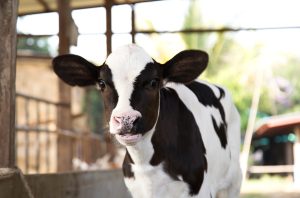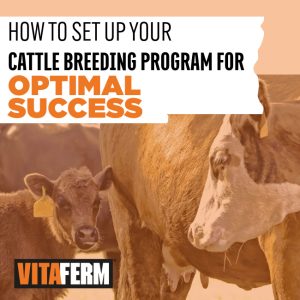
Weaning Calves
Weaning calves is perhaps one of the most stressful times in a cow-calf operation. The bawling calves are stressed, their mama cows are confused, and the producer is trying to make sure everyone stays where they need to be.
However, with proper preparation, good management practices, and a solid plan, you can lessen the stress incurred on your cattle and yourself at weaning time.
When preparing for weaning and making a management plan, there are several conditions to contemplate. You’ll want to consider the environmental factors that you’ve faced during the year, such as precipitation and temperatures, which impact feed availability.
Also, consider calf age and size, cow condition, and the market. That way, you’ll know if there will be strong demand for your calves when you are ready to sell them.
Cattle Nutrition Experts
VitaFerm® is an established brand of vitamin and mineral supplements designed to maximize energy and forage utilization for successful beef production. Our products support cattle producers looking to maximize their operations. Best of all, VitaFerm products ensure balanced nutrition for livestock.
The VitaFerm brand is the flagship brand of BioZyme Inc., BioZyme creates powerful solutions that improve animal performance and support producer profitability in the agricultural industry.
Our mission: undeniable positive impact on the health and wellness of your animals and your business.
Timing is Everything
The industry average for weaning calves is 6-to-8-months-old, with most calves weaned between 7-and 8-months-old. The age you wean will be most dependent on available feed resources and the condition of the cows. That advice comes from Chris Cassady, Ph.D., Director of Beef Technical Sales at BioZyme® Inc.
You will also want to schedule weaning calves when you can get the most out of them financially, either through retained ownership or through a repeat or ready buyer. Remember, weaning is also when you are trying to breed back a cow and grow a new pregnancy, not just continue to grow the current calf at side.
“On years that we are experiencing drought, and our cows are in a little tougher shape, it is an easier choice to consider early weaning,” said Cassady, whose family also owns a registered Angus operation in central Illinois. “Now, if you have a really good year, and you have a warm spring with lots of rain and lots of grass, you might be ok to go longer, closer to 8 months old.”
In addition to cow condition and feed availability, Cassady suggests keeping a close watch on calf supply and demand in the marketplace. It is wise to wean and sell them when you think you can capture the most profit. If you think there might be an upcycle in the market and demand is going to increase, then it is might be time to wean.
Early Weaning Advantages
Like Cassady mentioned, early weaning has advantages. Typically, early weaning occurs when the calves are 3 to 5 months old. Weaning calves early is the easiest way to help manage your cows’ condition. Furthermore, if you pull a big calf from her early on, you won’t have to put as much feed or hay back into her to get her condition back.
“If you have a cow that is losing weight or one you want to keep from getting too thin, you pull that calf off early because there is nothing that will suck the condition off of a cow faster than a really big, heavy old calf on her side,” he said.
Be Proactive with Health, Nutrition
It is imperative to keep these young calves as healthy as possible before weaning. Cassady suggests getting calves their proper vaccinations or vaccine boosters about a month before weaning. Because each geographic location and situation is slightly different, consult with your veterinarian on what exactly you need. Most pharmaceuticals offer a 7-way or 5-way vaccine to treat multiple bugs. You will also want to worm calves when you vaccinate them.
“If you wait until weaning to vaccinate, that will cause extra stress on the calves. Their immune system is going to be compromised in the first place, and the extra stress will impact the effectiveness of the vaccine, so plan ahead,” he said.
Of course, nutrition is crucial to eliminating your calves’ stress and continuing its post-weaning performance. It is especially important to keep that post-weaning gain going if you sell them as yearlings. It is vital to keep their diets somewhat consistent with what they have been accustomed to.
Cassady said that a huge, significant diet change will only add to the stress and confusion, so plan accordingly.
Weaning Methods Impact Stress
It is impossible to wean without stressing both the calf and the cow. However, particular strategies will cause less stress on both parties and are more calf-friendly.
Let’s look at some weaning strategies from least to most stressful:
Low Stress: Fence line Weaning
Fence line weaning is the least stressful method when weaning calves from cows. With fence line weaning, you separate the calves from their mothers. Then, pen them across the fence from one another, where they can still see and hear each other. Research proves that calves will eat more and put on pounds faster when using the fence line method.
Low Stress: Day Weaning
Day weaning is a gradual weaning method. The cow and calf are separated during the day and reunited in the evening for a window of time. This way, the calf can nurse in the morning and evening. This method is most common with livestock exhibitors who are getting calves broke and ready to show.
Moderate Stress: Two-Stage Weaning
Another less common strategy is two-stage weaning. Stage one involves putting a plastic slat or nose guard into the calf’s nose to prevent it from nursing. The pairs still run together, and the calf can still drink water and eat grass. However, it can’t nurse and after a week to two weeks will not have the desire to suck.
Stage two happens after the nose guard has been in the calf for about 10 to 14 days. When removed after that period, you separate the cow and calf. The two-stage method is thought of as less stressful than the traditional abrupt method, since it breaks weaning into two phases that are both less stressful.
However, this method requires more labor and cost. You will have to handle calves twice—once to insert and once to remove the nose guard. And then there is the added cost of the noseguard. Those are about $2-$3 per calf.
High Stress: Abrupt Weaning
Another commonly used approach is abrupt weaning. With this method of weaning the calves from the cow, the cows and calves are separated but remain on the same land. The cattle might be able to hear each other, but they can’t see each other, so the calves become accustomed to being alone.
High Stress: Load-and-Go Weaning
Load-and-go weaning is one of the most stressful weaning methods still in use. In fact, it’s used quite regularly. Many producers will wean calves, load them in the trailer and take them to the sale barn immediately. Though high-stress for the calves, there are good reasons why this might be more viable for your operation. This method is usually used when space and labor is in short supply.
The biggest problem, however, is that it doesn’t allow the calves time to recover from the stress of being removed from their mothers. This can heighten the stress response in the calves you immediately haul and introduce to a new environment.
Keep your Calves Healthy with VitaFerm®
Regardless of the weaning system you choose, you will want to be mindful of the transition you make with their diet. If the calves have been on a total grass diet, you don’t want to feed them much grain. However, you do want to offer them high-quality hay or forage to continue them on a consistent diet. If you’ve had them on creep feed while they were still with the cow, continue the same creep feed for a two to three-week period post-weaning. Providing them with creep feed will help while transitioning them to a grower ration.
One thing that you will want to do to keep their gut healthy and to keep them eating is to provide them with a dose of VitaFerm Cattle Drench when you do wean them.
“Besides birth, this is the time that will really set a calf up for performance potential for the rest of its life. Keep them on a positive plane of nutrition. If too much damage is done, you’ll always have a chronically sick calf. You will constantly be behind and be spending money on more feed for it. That is where Amaferm’s technology is so crucial and helpful in that transition period,” Cassady said.
What is VitaFerm® Cattle Drench?
VitaFerm® Cattle Drench with the Vita Charge Technology is the first step to successfully weaning calves. This drench for cattle is designed to support digestive health before, during and after challenges. Contains AO-Biotics® Amaferm®, a prebiotic research-proven to enhance digestibility. Cattle Drench also contains MOS (mannan oligosaccharides) helps normalize the gut microflora and supports the immune system and enzymes to generate a more rapid digestive response.
Using this drench as you process the calves at weaning helps keep their gut healthy and functioning. We know that 70% of the immune response starts within the digestive system, so a healthy gut will lead to a healthy animal.
VitaFerm Cattle Drench is the first step in the Gain Smart Weaning Program. Each of the products in the Weaning Program—the Cattle Drench, VitaFerm Stress Tubs, and Gain Smart Minerals contain Amaferm.
Why Does Amaferm Matter?
Research shows that calves that are fed just 4 ounces of Amaferm daily are likely to increase gains by ¼ of a pound per day. More efficient gains lead to faster gaining, healthier calves.
Do you want to wean calves from cows in a low-stress, efficient manner? Do you want calves that gain healthy, economic pounds and ultimately add to your bottom line? Wean calves in a low-stress way and get them started right with VitaFerm Cattle Drench.
Get Your BioZyme Products Today!
Are you ready to wean your calves the stress-free way and incorporate VitaFerm Cattle Drench into your weaning program? You can buy BioZyme products from one of our dealers. Find a BioZyme dealer near you.
Want more timely and useful information? Sign up for our newsletter.


